 LATEST
ANTIQUES ARTICLE______________________________
Spooky Greetings
by
Bob Brooke
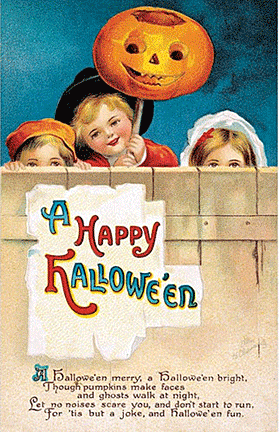 “HAPPY
HALLOWEEN!”—a greeting heard at parties and by trick o’ treaters as they
go from house to house seeking candy treats. But back in the 19th
century, people sent Halloween greetings by postcard. “HAPPY
HALLOWEEN!”—a greeting heard at parties and by trick o’ treaters as they
go from house to house seeking candy treats. But back in the 19th
century, people sent Halloween greetings by postcard.
Halloween has its roots in an ancient Celtic festival called Samhain,
celebrating the end of summer. The night marking the change of season
from summer to winter, the beginning of the Celtic New Year, was
supposedly filled with magic. On this day, ghosts and demons were free
to roam the earth, so villagers would wear ghastly costumes to fool the
spirits and make food offerings to the dead.
Halloween came to the United States in the form of masquerades,
house-to-house visits, and the jack o’ lantern, based on a myth about a
soul trapped on earth who was given the burning embers of hell to light
his way.
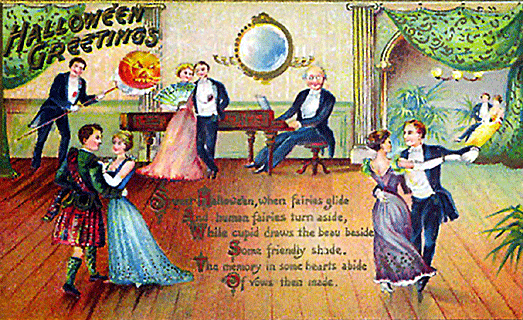
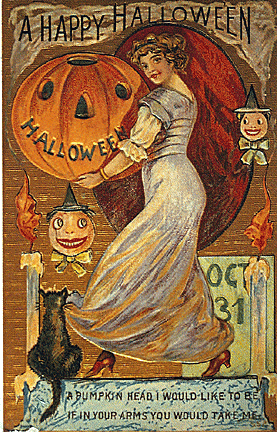 But
it was the Victorians who homogenized diverse Halloween traditions in
middle-class England and America. For them, it became a genteel holiday
about romance, parlor games, and child’s play. People even softened
ghost stories into tales of passion, as members of high society competed
to one-up each other with their Halloween parties. But
it was the Victorians who homogenized diverse Halloween traditions in
middle-class England and America. For them, it became a genteel holiday
about romance, parlor games, and child’s play. People even softened
ghost stories into tales of passion, as members of high society competed
to one-up each other with their Halloween parties.
The late 19th century also marked the beginning of the “golden era” of
postcards, which were the text messaging or social media of the
day—people sent these cheap greetings for any reason, particularly
holidays. This trend lasted until around 1918.
The early 20th century marked the golden age of Halloween postcards,
with hundreds of designs flooding the market.
 Halloween
had become a commercialized holiday, and the demand for themed postcards
skyrocketed. Publishers such as John Winsch, Raphael Tuck & Sons, and
International Art Publishing Company produced high-quality postcards,
employing skilled artists to create illustrations that captivated the
recipient’s imagination. Halloween
had become a commercialized holiday, and the demand for themed postcards
skyrocketed. Publishers such as John Winsch, Raphael Tuck & Sons, and
International Art Publishing Company produced high-quality postcards,
employing skilled artists to create illustrations that captivated the
recipient’s imagination.
Turn-of-the-century Halloween postcards featured cute, fat jack o’
lanterns topped with equally adorable chubby-cheeked children. Black
cats, which used to be burned at Christian festivals for being “witches
familiars,” were also cuddly icons of these cards, while the witches
were often depicted as very pretty ladies bringing messages of love.
In the late 19th century, the popularity of postcards as a means of
communication soared. Inspired by the success of Christmas and Easter
postcards, publishers began producing Halloween-themed postcards to
cater to the growing demand for holiday-specific greetings.
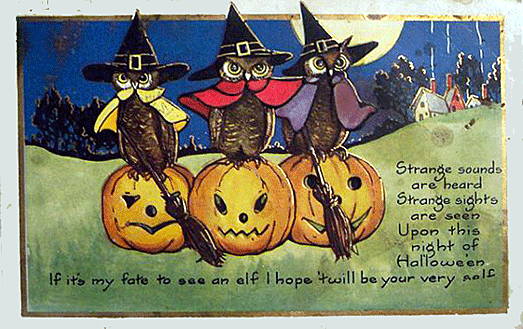
 The
earliest Halloween postcards can be traced back to the late 1800s, with
black cats, witches, and bats often depicted as the central motifs.
These early postcards were primarily printed in Germany, which was
renowned for its advanced printing techniques and skilled artists. The
earliest Halloween postcards can be traced back to the late 1800s, with
black cats, witches, and bats often depicted as the central motifs.
These early postcards were primarily printed in Germany, which was
renowned for its advanced printing techniques and skilled artists.
Halloween postcards became a way for friends and family to send
lighthearted greetings and well wishes during this spooky season.
Halloween postcards often featured a variety of both spooky and playful
imagery and funny captions, capturing the spirit of Halloween in a
visually appealing and entertaining way.
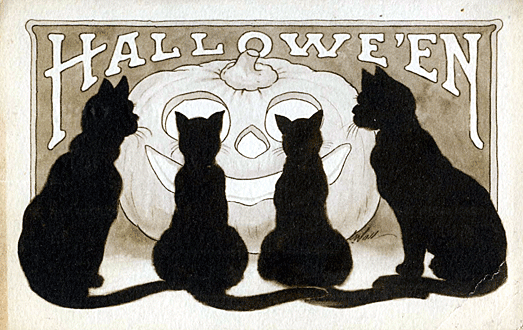
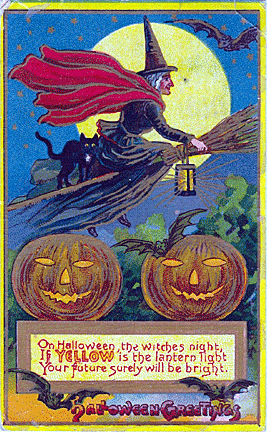 Black
cats, with their association with witchcraft and superstition, were a
major presence on in Halloween postcard artwork. They were often
depicted in mischievous poses, adding a playful and sometimes mysterious
element to the graphics. Black
cats, with their association with witchcraft and superstition, were a
major presence on in Halloween postcard artwork. They were often
depicted in mischievous poses, adding a playful and sometimes mysterious
element to the graphics.
Witches, another staple of Halloween, were commonly portrayed on
postcards, either flying on broomsticks or stirring cauldrons filled
with bubbling potions. Then there’s the beautiful and alluring variety
of witches – more like bewitching young women wearing black or red robes
and pointed hats.
Skeletons and ghosts, eternal symbols of the macabre, were also
prevalent on vintage Halloween postcards. These spooky characters added
a touch of fright to the otherwise lighthearted and whimsical imagery.
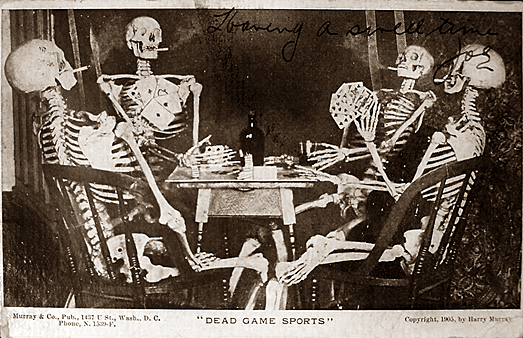
Pumpkins, with their association with harvest and the tradition of
carving jack-o’-lanterns, are more commonly seen on these cards than
anything else. Collectors and dealers will often use the acronym “JOL”
to refer to a Jack-o-Lantern on a vintage card.
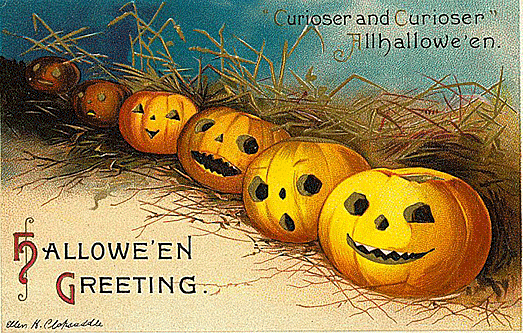
Anthopomorphic Halloween postcards, characterized by the weird depiction
of human-like features on non-human objects like vegetables and hot air
balloons, make for lots of laughter and puzzled expressions. Knife-weilding
men with watermelon bodies, grinning pumpkin heads cutting a cake, and a
pickle wearing a top hat and cuff links, strutting off into the dark are
just a few examples.
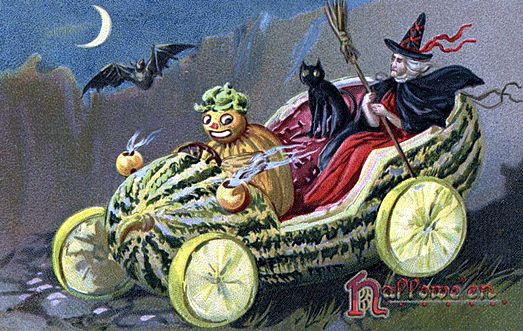
 Edwardian
romanticism filled the accompanying verses which said things like, "On
Halloween, take the seeds from a Pumpkin, place them in front of the
sofa in the form of a cross―then the Witches won't bother you. That's a
hard name to call ma and pa but they were young themselves once and
won't mind it." Or, "On Halloween, Goblins have been known to fly away
with Fair Maidens. Therefore 'tis best to have some one hold you and
tightly, too―because Goblins are strong." Edwardian
romanticism filled the accompanying verses which said things like, "On
Halloween, take the seeds from a Pumpkin, place them in front of the
sofa in the form of a cross―then the Witches won't bother you. That's a
hard name to call ma and pa but they were young themselves once and
won't mind it." Or, "On Halloween, Goblins have been known to fly away
with Fair Maidens. Therefore 'tis best to have some one hold you and
tightly, too―because Goblins are strong."
One particularly popular superstition for romantic Halloween cards shows
a young woman looking into a mirror at the stroke of midnight to see the
face of her true love, using the light of a jack o’ lantern. At times,
she’s pictured looking into a hand mirror at a larger mirror over her
shoulder, and other times, she’s looking directly into the larger
mirror, as the image of her future husband hovers ‘over her shoulder.
Postcard Artists
 Several
artists of are highly sought after by Halloween postcard collectors. Several
artists of are highly sought after by Halloween postcard collectors.
Ellen Clapsaddle was a prominent artist known for her charming
illustrations and use of vibrant colors. She began her work in 1906,
becoming the most prolific of all the Halloween postcard artists. She
produced cards with distinct illustrations of children some of the most
collectible Halloween cards today for Raphael Tuck and Sons,
International Art Publishing Company, and Wolf Publishing Company, a
subsidiary of Inter-Art that Clapsaddle launched herself.
 Another
highly collected artist is Samuel Schmucker. Despite partial paralysis
from childhood polio, Schmucker pursued an artistic career. He began as
a commercial artist in 1905 and his success with fashion illustrations
led to collaborations with the Detroit Publishing Company, producing 52
postcards across 8 sets. This achievement paved the way for designing
numerous holiday postcards for the John Winsch Company, featuring his
wife as the Winsch Girl. Schmucker’s Halloween postcards often featured
sexy witches, black cats, and pumpkins. His detailed and colorful
designs contributed to the postcard craze, making his work highly
collectible today. Another
highly collected artist is Samuel Schmucker. Despite partial paralysis
from childhood polio, Schmucker pursued an artistic career. He began as
a commercial artist in 1905 and his success with fashion illustrations
led to collaborations with the Detroit Publishing Company, producing 52
postcards across 8 sets. This achievement paved the way for designing
numerous holiday postcards for the John Winsch Company, featuring his
wife as the Winsch Girl. Schmucker’s Halloween postcards often featured
sexy witches, black cats, and pumpkins. His detailed and colorful
designs contributed to the postcard craze, making his work highly
collectible today.
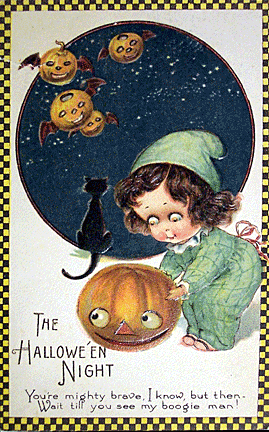 Jason
Frexias, meanwhile, produced holiday cards for Winsch with round-faced
toddlers with starfish hands. Because Frexias didn’t copyright his work,
his images would be copied. An illustration of a child originally
perched on a jack o’lantern would be lifted and placed on an Easter egg
or a heart for a Valentine’s Day card. These knockoff illustrations for
which Frexias no payment, lack the detail of the original. Jason
Frexias, meanwhile, produced holiday cards for Winsch with round-faced
toddlers with starfish hands. Because Frexias didn’t copyright his work,
his images would be copied. An illustration of a child originally
perched on a jack o’lantern would be lifted and placed on an Easter egg
or a heart for a Valentine’s Day card. These knockoff illustrations for
which Frexias no payment, lack the detail of the original.
Grace Gebbie Drayton, known for her iconic Campbell’s Kids, made
Halloween cards for Raphael Tuck and Sons showing the similar big-eyed
chubby-cheeked kids. Comic-strip artist Clare Victor Dwiggins made a
gorgeous set of unsigned Halloween cards in fantasy style featuring a
beautiful “witching queen” presumably based on his wife, who was often a
model for the lovely ladies on his cards.
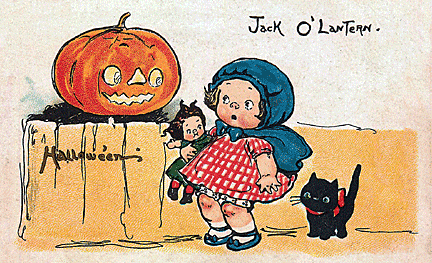
A prolific artist known for her charming portrayals of children, Frances
Brundage had a remarkable career spanning 65 years. Specializing in
illustrations, she created over 200 books and gained recognition for her
work with Raphael Tuck & Sons, Samuel Gabriel Company, and Saalfield
Publishing.
Postcard Publishers
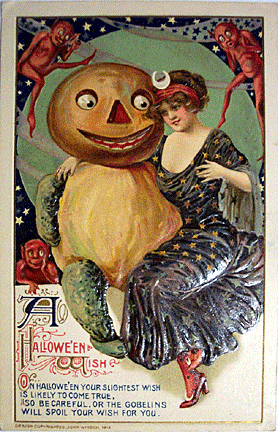 John
O. Winsch of New York published the most beautiful and most collected
Halloween postcards between 1911 and 1915. His firm used heavy, rich
inks and embossing on his cards, and sent them to Germany to be printed.
Some appeared in sets of six, but most came in sets of four. Some of
these postcards had booklets attached, and still others had die-cuts.
Thanks to the Payne-Aldrich Act, which increased the tariff on imported
cards, Winsch cards were two for a nickel, while cards printed in
America only cost a penny. Collaborating with European artists,
including Samuel L. Schmucker and Fred Kolb, Winsch produced nearly
4,000 unique card designs. Though he published most of his cards in
Germany, he had some printed in Philadelphia. Unfortunately, other
publishers copied his designs, misleading customers and capitalizing on
Winsch cards’ higher prices. John
O. Winsch of New York published the most beautiful and most collected
Halloween postcards between 1911 and 1915. His firm used heavy, rich
inks and embossing on his cards, and sent them to Germany to be printed.
Some appeared in sets of six, but most came in sets of four. Some of
these postcards had booklets attached, and still others had die-cuts.
Thanks to the Payne-Aldrich Act, which increased the tariff on imported
cards, Winsch cards were two for a nickel, while cards printed in
America only cost a penny. Collaborating with European artists,
including Samuel L. Schmucker and Fred Kolb, Winsch produced nearly
4,000 unique card designs. Though he published most of his cards in
Germany, he had some printed in Philadelphia. Unfortunately, other
publishers copied his designs, misleading customers and capitalizing on
Winsch cards’ higher prices.
Another publisher, Raphael Tuck & Sons, founded in the 19th century, was
a pioneer in the postcard industry. The firm earned a reputation for
their innovative lithographic techniques and artistic designs. Renowned
for their “Artistic” series which can be identified by the notation
printed on the backs of their cards, their postcards featured intricate
illustrations, often depicting landscapes, holidays, and charming
scenes.
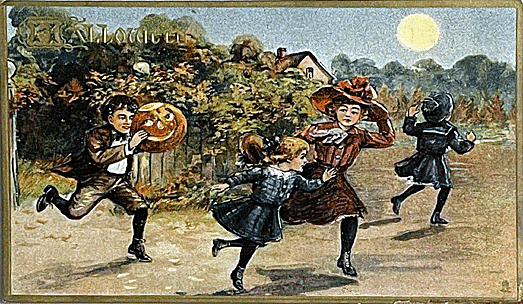
 Gibson
and Company of Cincinnati, Ohio, emerged as a printing business in
the1850s. As the 20th century approached, the company began
collaborating with individual artists for their holiday cards. Notable
ones included, among others, Bernhardt Wall and Kathryn Elliott. Their
distinct designs were especially popular during Halloween. Gibson
and Company of Cincinnati, Ohio, emerged as a printing business in
the1850s. As the 20th century approached, the company began
collaborating with individual artists for their holiday cards. Notable
ones included, among others, Bernhardt Wall and Kathryn Elliott. Their
distinct designs were especially popular during Halloween.
Collecting Halloween Postcards
Collecting Halloween postcards has been a popular hobby for enthusiasts
of Halloween ephemera for decades. Those that have been well-preserved,
with no tears, stains, or significant wear, are more desirable to
collectors.
The scarcity of some designs and the historical value associated with
them make them highly sought after by collectors. When collecting
vintage Halloween postcards, it is important to consider factors such as
condition, rarity, and the appeal of the artwork or artist.
As the 1950s approached, the popularity of Halloween postcards began to
decline.
<
Back to Antiques Archives
|
